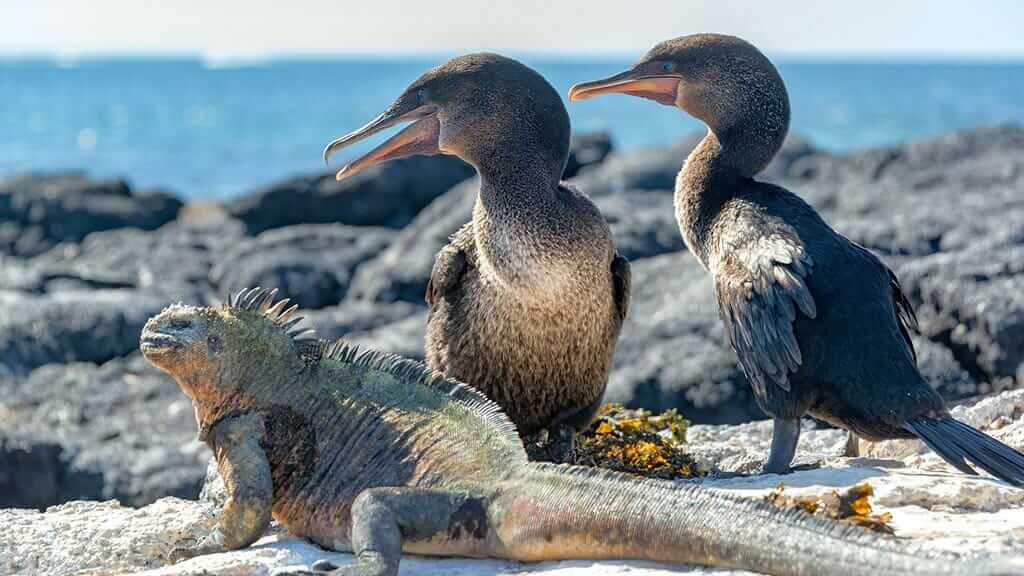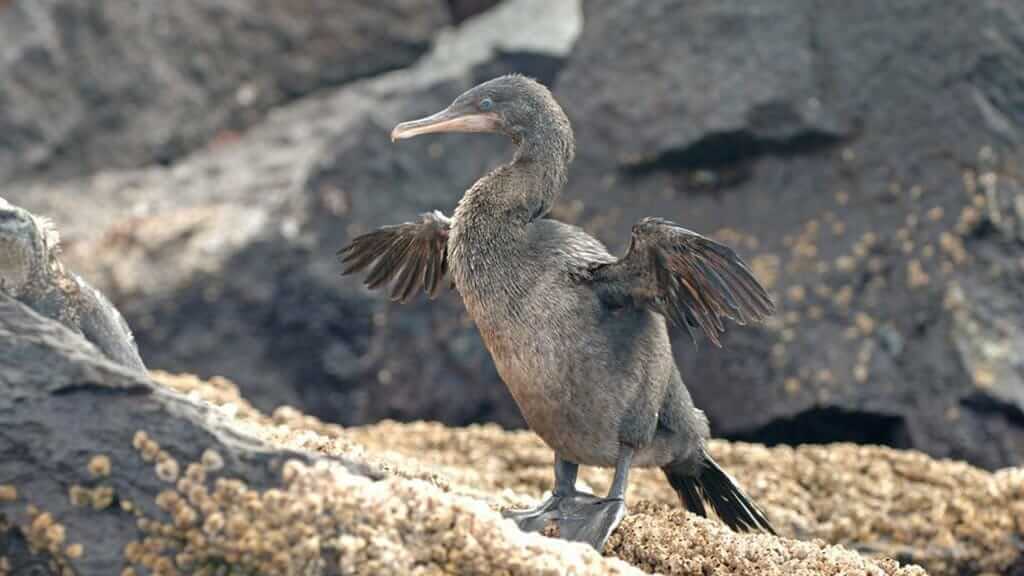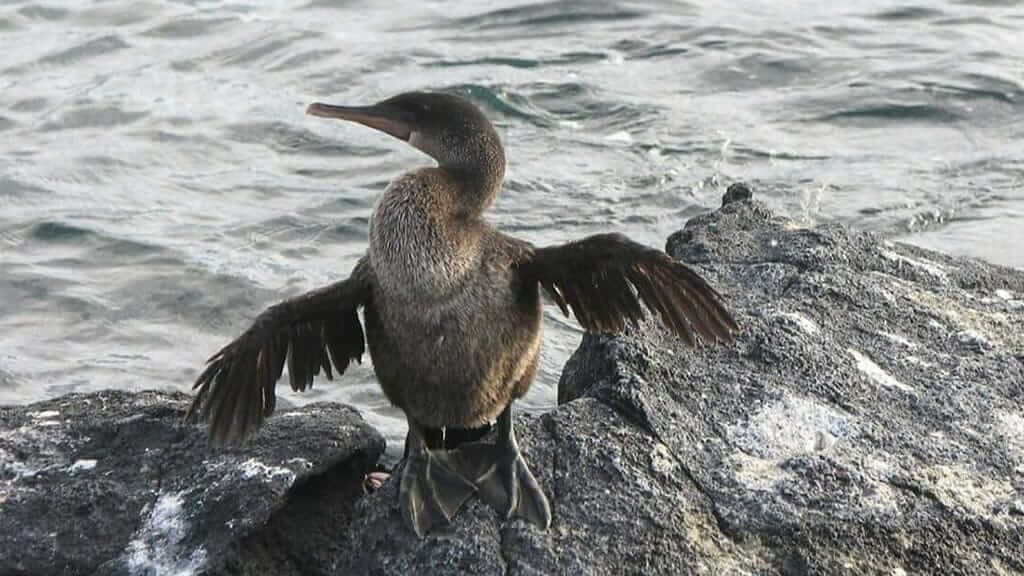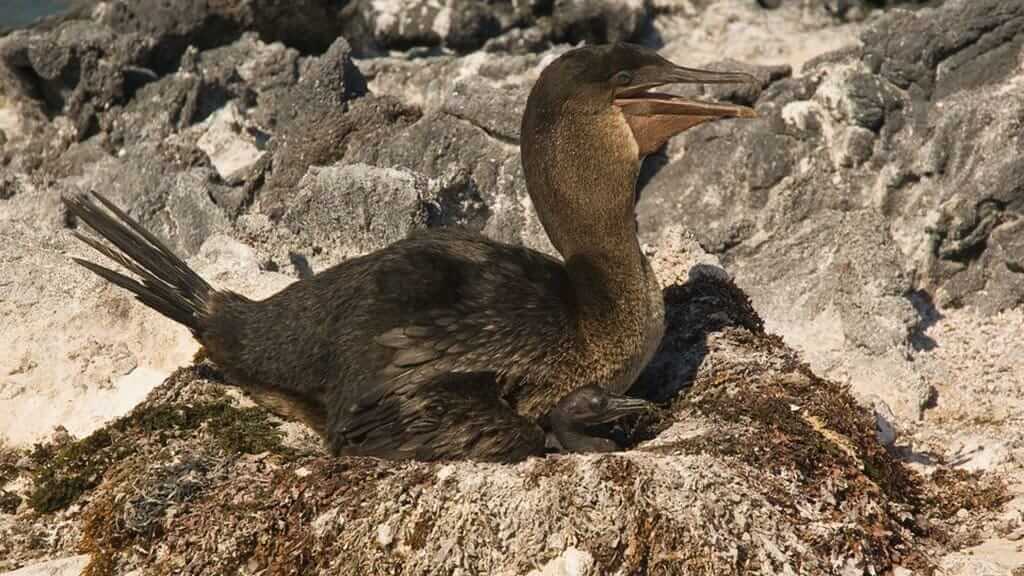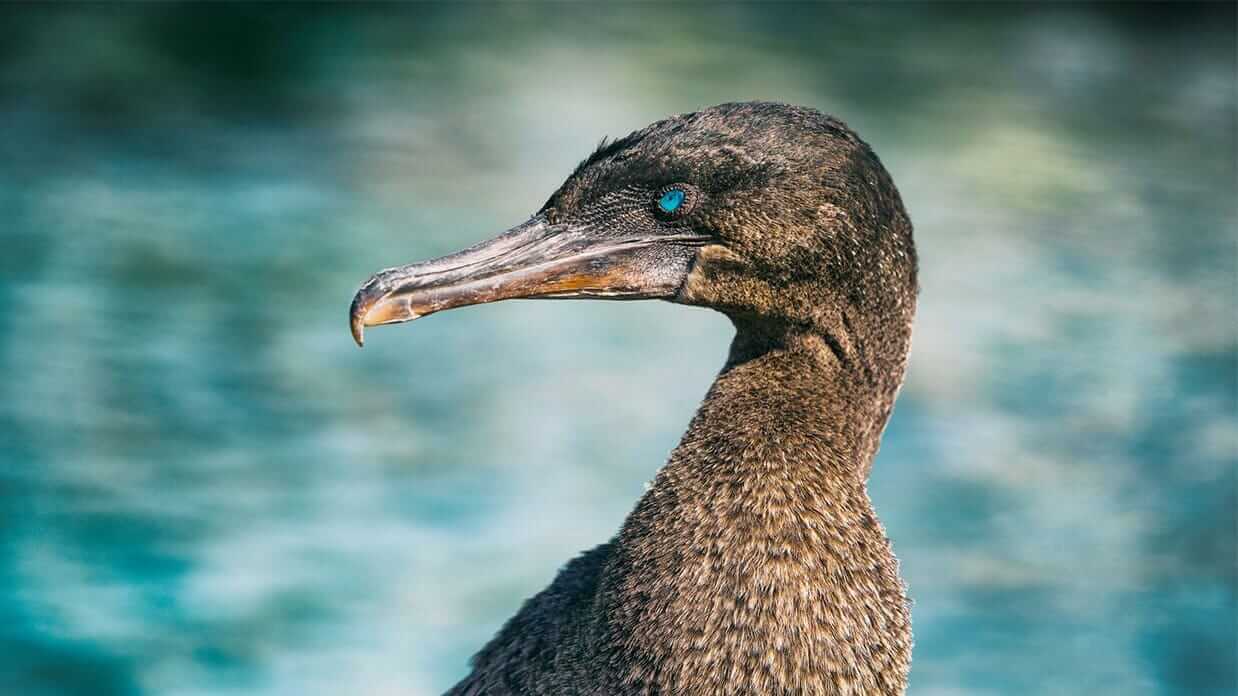GALAPAGOS FLIGHTLESS CORMORANT
The Galapagos Flightless Cormorant is the peculiar case of the bird that forgot how to fly. Today, this unusual bird has short stunted wings and a fascinating story to tell.
At the Galapagos Islands, the Flightless Cormorant had to evolve in unique ways to survive in this remote volcanic habitat. Galapagos Cormorants learned to become proficient deep ocean divers, and eventually lost the use of their now tiny wings.
Flightless Cormorants are endemic to the Galapagos Islands, so you can only find them here. We'll tell you exactly where and when to spot this interesting bird.
Keep reading to learn the whole Galapagos Flightless Cormorant story. Why did the Cormorant lose its ability to fly? Plus heaps of other fun Galapagos Cormorant facts.
SECURE YOUR GALAPAGOS TRAVEL
Get a FREE personalised quote todayFLIGHTLESS CORMORANT = ENDEMIC GALAPAGOS SPECIES
Conservation Status: Vulnerable
Scientific Name: Phalacrocorax harrisi
How To See A Galapagos Flightless Cormorant?
Today there are approximately 1,000 breeding Galapagos Cormorant pairs. They live and nest on just 2 specific islands to the west of the archipelago, so careful Galapagos trip planning is needed to find them.
Where To See Flightless Cormorants?
In order to spot a Galapagos Cormorant, visitors need to visit Fernandina island, and/or the western coast of Isabela Island. These islands are too far afield to visit on a day tour, so the only way to see them is aboard a Galapagos Islands Cruise. Not all cruise itineraries make stops at these islands, so be sure to check carefully with your agent before booking.
It's no accident that Galapagos flightless cormorants choose to hang out on these specific islands. The waters in the Bolivar Channel (between Fernandina & Isabela) are the coldest of the Galapagos archipelago. Why does this matter? The Humboldt Current arrives from Antarctic waters from the south and is rich in nutrients. This results in perfect Flightless Cormorant feeding grounds. Incidentally, the largest Galapagos penguin colonies are found here too, for the very same reason.
When to see Galapagos Cormorants?
The good news is that Flightless Cormorants live year-round at the Galapagos islands, so visitors can enjoy watching them anytime.
The cormorant nesting season runs from May to October, beginning when the Humboldt current starts to arrive. This is prime feeding season as the colder waters are nutrient-rich, attracting fish and octopus, a favorite cormorant meal. The Galapagos Flightless Cormorants take advantage of the abundant food to mate and produce offspring, giving their chicks the best possible chance of survival.
Want to see a Galapagos Flightless Cormorant? Contact us for a FREE GALAPAGOS TOUR QUOTE, and more information about how to plan your vacation at the Galapagos Islands.
GET FREE ADVICE
From a Galapagos destination expert todayEverything You Ever Wanted To Know About Galapagos Flightless Cormorants
Flightless Cormorant Appearance
The distinguishing feature of a Flightless Cormorant is the wings. They are much shorter than they should be, and appear stunted. Many visitors are taken aback at first sight - it's certainly unusual to see a bird with such tiny wings. Their eyes also stand out thanks to the striking turquoise color.
Adult Galapagos cormorants have black plumage on top and dark brown underneath. Adolescent flightless cormorants can be recognized by their darker-colored eyes. Males are typically 35% larger than females.
Flightless Cormorant Evolution
It's time to tell the remarkable story of the Galapagos Flightless Cormorant.
Let's rewind back to the beginning. How did cormorants originally arrive at the Galapagos Islands? Remember, the Galapagos islands are remote, located 1000km from the South American mainland. How could a flightless bird make this journey? Curiously their ancestors were in fact perfectly good flyers. So, they would have flown with ease out to the Galapagos Islands from the mainland.
Cormorants first set foot at Galapagos even before Isabela and Fernandina islands existed. They must therefore have settled on older islands first. Eventually, the cormorants migrated west in search of richer feeding sites.
All of this brings us to the interesting part of the tale. Why did the Galapagos Cormorants lose their ability to fly?
On Fernandina and Isabela islands, there are few land predators to threaten bird species like cormorants. At the same time, their best food sources are found deep in the ocean. In order to survive and thrive in this habitat, the cormorant needed to adapt.
At their new home, the Galapagos Cormorant wings were no longer essential. There was no need to fly to escape other animals. Large wings were also a hindrance to deep-dive for food.
So, the Galapagos Cormorant went through two important evolutionary adaptations. First, they developed powerful hind legs for maneuvering underwater. Next, their wings shrunk and declined, leaving tiny wing stubs in place of their previously powerful limbs. The cormorants at Galapagos were now more streamlined to reach deeper depths.
Thus the Galapagos Cormorant became a Flightless Cormorant. A highly skilled swimmer and diver, but now completely unable to fly.
Flightless Cormorant Diet
The preferred Galapagos Flightless Cormorant diet consists of eel and octopus. They hunt by deep diving to the ocean floor using their powerful hind legs. They can reach into rocky crevasses with their long necks to spear their prey. Regular dives go as deep as 10-15 meters, but they have been known to dive up to 5 or 6 times deeper in search of tasty morsels.
Flightless Cormorant Habitat
Galapagos Cormorants like to nest on flat lava rocks, close to shore for easy access to the sea. It's easy to see cormorant nesting sites during a panga ride along the coast, or during a snorkeling tour.
Behavior of Flightless Cormorants
Flightless Cormorant couples perform an interesting courtship ritual. They begin in the water by intertwining their necks and swimming around one another in a tight circle. Once this flirting is over they take to land. It's time to build a home together. Flightless Cormorant nests are made of seaweed and other ocean debris. The male will often present gifts (stones, twigs, and washed-up waste) to the female, to make the nest more homely.
An average of 3 eggs is laid per Galapagos Cormorant clutch. The proud parents take turns incubating the eggs for 35 days. Similarly, they share the responsibility of protecting, feeding, and raising their chicks. Hatchlings need to be looked after for over 70 days before they can fend for themselves.
Sometimes, an interesting cormorant mating quirk may also occur at Galapagos. In good years, when food supplies are especially abundant, the female Flightless Cormorant has been known to leave the dirty work of child-rearing to the male. Worse still, she then pairs up with another male to produce another family. There's enough food to go around, so why not?
Is The Flightless Cormorant Endangered?
The Flightless Cormorant is listed as Vulnerable by the IUCN. Reasons vary, but this unique species is not helped by its limited range. The poor Flightless Cormorant is only found on two islands on the planet. Having lost the ability to fly, the Galapagos Cormorant is now stuck on those islands, without the opportunity to migrate should the need arise. The fate of the Galapagos Flightless Cormorant is in the hands of the health of the habitat where they now live.
Flightless Cormorants have few natural predators. Their main natural threats are Galapagos snakes and Galapagos Hawks on land, and sharks in the sea. But it's not only natural predators that they need to look out for. Invasive species introduced by humans also pose a threat, principally cats and rats.
Another major threat to the Galapagos Flightless Cormorant is the El Niño weather phenomenon. El niño occurs every decade or so, affecting the whole coast of South America. El niño causes a small rise in sea temperatures, which in turn depletes the important nutrients found in the ocean. Fewer algae, plankton, and nutrients mean fewer fish, which results in hungry cormorants.
The last major El Niño event occurred back in 1982/3 and wiped out around 50% of the Galapagos Cormorant population. Not only were adults starving to death, but they were also unable to breed that year. Fortunately, cormorants are fast breeders, but even so, a severe El Niño causes devastation.
The Galapagos Conservation Trust & Charles Darwin Foundation perform ongoing surveys of Flightless Cormorants to monitor population sizes. In September 2020 they were delighted to report record numbers of Galapagos cormorants nesting at Isabela and Fernandina. The recent La Niña event was believed to have helped, as temporarily cold ocean currents brought more food for marine species. Perhaps also the pause in tourist numbers during the pandemic was beneficial.
Interesting Facts About The Flightless Cormorant
• The Flightless Cormorant is both the heaviest and rarest of all cormorant species in the world (there are 29 global cormorant species in total).
• In order to regain their ability to fly, the Galapagos Flightless Cormorant would need wings at least two-thirds larger than those they currently have.
• Surprisingly, the small wings of a Flightless Cormorant are not waterproof. As a result, it's common to see them spreading their wings in the sun to dry out after diving.
The #1 Trusted
Galapagos Travel Agency
If you enjoyed this post about the Galapagos Cormorant, check out more information about Galapagos Islands Birds.
In conclusion, few birds in the world boast a story as quirky as the Galapagos Flightless Cormorant. They are one of the best examples today of species evolution. The evidence is clearly visible in their puny wings. But don't feel too sorry for them. What they have lost in flight, they gain in the water. By transforming themselves into strong divers they can fill their bellies at leisure. It is through evolution that the Galapagos Cormorant has learned to survive and thrive here.



